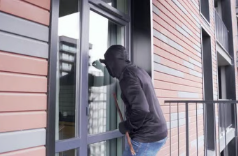Securing your home against intruders involves a combination of physical security measures, technology, and good practices. Here are comprehensive steps you can take to enhance the safety of your home:
1. Fortify Entry Points
- Install Strong Doors: Use solid wood or metal doors for entry points. Ensure all doors have high-quality deadbolts.
- Reinforce Window Security: Use window locks or security film to make glass more difficult to break. Consider installing wood dowels or security bars on sliding doors and windows.
- Secure Patio and Sliding Doors: Add a security bar or a specialized lock to sliding doors to prevent them from being easily forced open.
2. Invest in Quality Locks
- High-Security Locks: Consider investing in high-security locks that are resistant to picking and bumping.
- Keyless Entry Systems: Electronic locks provide additional security and convenience. They can be programmed to allow access for guests and can be changed easily if lost.
3. Install a Security System
- Alarm Systems: A professionally monitored alarm system can deter intruders and alert you and authorities in case of a break-in.
- Surveillance Cameras: Install security cameras at key entry points, which can serve as a deterrent and provide evidence in case of an incident.
- Smart Home Security: Consider smart home security systems that allow for remote monitoring and notifications to your smartphone.
4. Enhance Outdoor Security
- Bright Lighting: Use motion-activated lights around the exterior of your home, especially near entry points and dark corners.
- Landscaping: Keep bushes and trees trimmed to eliminate hiding spots for intruders. Use thorny bushes below windows as a natural deterrent.
- Fencing: Install a sturdy fence around your property to create a physical barrier. Ensure gates are locked.
5. Practice Smart Habits
- Lock Doors and Windows: Always lock doors and windows when leaving your home or going to bed, even if you’re home.
- Be Cautious with Keys: Avoid hiding spare keys in obvious places. Instead, consider giving a spare key to a trusted neighbor.
- Social Media Awareness: Avoid posting your location or plans on social media, especially while you’re away from home, to prevent attracting unwanted attention.
6. Get to Know Your Neighbors
- Community Watch Programs: Participate in or establish a neighborhood watch program. Building relationships with neighbors fosters community vigilance.
- Inform Neighbors: Let trusted neighbors know if you’re going away, and ask them to keep an eye on your property.
7. Secure Garages and Sheds
- Strong Locks: Ensure garages and sheds have sturdy locks, as they can contain tools that intruders might use to break into your home.
- Park Smart: Keep vehicles locked and remove any valuables from sight.
8. Use Alarm Signs and Stickers
- Visible Deterrents: Even if you don’t have a full security system, displaying alarm system signs or decals can deter potential intruders.
9. Conduct Regular Security Checks
- Assess Vulnerabilities: Periodically walk around your home and evaluate areas that may need enhanced security.
- Stay Updated: Be aware of local crime trends and adjust your security measures accordingly.
10. Educate Your Family
- Safety Plans: Teach family members how to recognize suspicious behavior and what to do in case of an attempted break-in.
- Emergency Contacts: Have a list of emergency contacts and procedures readily available for the whole family.
By integrating these security measures, you create a comprehensive strategy that enhances the safety of your home and deters potential intruders. Remember, the goal is to create layers of security that work together to protect your property and loved ones. Regularly review and update your security practices to adapt to changing circumstances and emerging threats.
